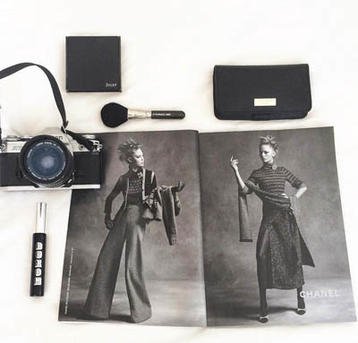Putting together a short, snappy video is easy, right? You just get the talent to press record on the video camera and then chat about the product, right?? Wrong! Creating a short video takes hours of work – from the preparation, to filming, to editing. When you add sponsorship to the mix, it makes things even more complicated – as the talent needs to ensure the client’s messages are delivered in a succinct but educating/entertaining way.
To find out just what processes take place in the creation of a sponsored video, BEAUTYDIRECTORY sat down with three experts in the field.
The long and short of it
While there is no exact set of timings when it comes to producing a sponsored video, different publications have a general idea of how long it takes. BEAUTYcrew editor Carli Alman advises on a rough example of timing: “Generally, the process of scripting (which is from first draft to final approval) can take about a week, filming itself can take [at a] minimum half a day (depending on how many angles and how wordy the script is), and editing can take about a week internally."
These timings are similar to beautyheaven. “In general a 90-second video in one location with one talent will take up to one day (eight hours) to film. More time would be needed if multiple talent is used, the video is shot at different locations, and special effects apply. In general, a 90-sec video will then take up to three days to edit,” says beautyheaven video producer Melissa De Coster.
The creation process
So why does it take such a long time? “A huge amount of work and creativity goes into video production. Creative people are always passionate, they want perfection, but a good producer needs to keep an eye on the time. Our producer polices time and ensures everything runs smoothly – but does it with a smile,” explains The Carousel publisher Robyn Foyster.
When creating a sponsored video, the planning and strategising takes far more time than the actual shoot. “The bulk of the work is done before filming and in editing and post-production,” reveals Alman. “If you show up on the day and you don’t have a script/an idea of what you’re doing, your filming can go on for hours longer than needed. If you don’t have your script or an outline of where the video is going, the editing takes much longer (and you can end up with a different focus to the video than the brand would like).
“Nutting out all of the details and dedicating enough time helps streamline the process and make for an end result that’s close to exactly what the client is looking for. If you try to cut corners and rush things, that’s often when you end up actually prolonging the process to fix mistakes/misunderstandings.”
Explaining this further, De Coster adds: “On average [a 90-second video] results in at least two hours of [raw] footage. The video editor firstly has to go through all that footage to select the right moments. Then he/she has to place them in order (it often happens that footage can't be shot in order), and has to create smooth transitions between each image. That normally takes about half a day.
“The majority of the work lies in the adding and perfecting [of] animated text, visuals and sound (such as voice-overs, effects and music). Lastly, the video editor will colour grade the entire video to give it the right look and feel.”
Sticking to the script
Sponsored videos traditionally come with a request for a script, but is one always necessary? “Given video is expensive to produce, I would say nine times out of 10 ‘Yes’. Having said that, we have produced really engaging short 20- and 30-second videos for clients which rely on graphics rather than the spoken words, so with these, there is a brief but no script is required,” says Foyster.
For beautyheaven, a script is a non-negotiable. “Absolutely, preparation is key and therefore the production process will be more efficient and effective. Plus, an approved script is like a contract between a brand and the video production team; everything in the script will have to be recorded. Nothing less, nothing more. It makes sure that every party knows what has to be done to get the desired result,” explains De Coster.
Like with the whole video process, writing a script is a time-consuming venture. “At The Carousel, we employ former TV producers who are accustomed to writing scripts. However, every script takes time to produce because they are often written to a client brief. We spend at least one day on pre-production, generally speaking, but usually expect to write more than one script,” reveals Foyster. At beautyheaven, scripts generally have between half a day and a one-day turnaround.
When it comes to writing scripts, the producer needs to know about key messaging, the concept and creative idea, the style – e.g. animation, voice-over, presentation etc, and the desired length of the video.
Short and snappy
When a brand requests a video package, they often also request a 15-second video for social media, which can be just as time-consuming to produce as the original full-length video. “There are times when it can take as much thought and effort to creating a 15-second video as it does for a longer video,” advises Foyster. De Coster explains this further, by warning: “It adds to the creative process in such that the brainstorming, scripting or storyboarding might take up more time.”
Ideal length
When determining the optimal video length, it is good to take into account the content of the video as well as the device and platform the audience will be viewing it on. “There is no one size fits all and that’s because great content comes in all forms and lengths. But as a rule of thumb, entertaining content is preferably snackable so is arguably no more than two minutes. However, a documentary style video or step-by-step instructional video can easily hold interest for a three-minute plus duration on a website. But sponsored videos running on Facebook, for instance, are more optimal at 30 to 45 seconds, and Instagram vines are best shorter still at 15 seconds or less,” says Foyster.
To give a general outline of ideal timings, De Coster has put together the below graph.

Final words of wisdom
Before heading off into the wilderness of negotiating video production, our experts deliver some final snapshots of advice. “The best branded content is always seamless and engaging. It’s not good to have overt product placement. Strong messaging can be achieved without that,” advises Foyster.
De Coster adds: “My top tips for brands buying sponsored videos are to trust the experts: work with an experienced video team and let them guide you. Brands sometimes are too close to accept new, innovative ideas that could really work for them. Also, always stick to the plan: be aware that during the shoot and editing, the video team can't always make changes because of factors such as they weren't part of the script, they are technically impossible, or it doesn't fit your budget or the timeline (and you might be charged additional fees). So make sure you are happy with the concept before you approve the script.”




